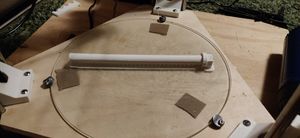No edit summary |
|||
| Line 22: | Line 22: | ||
== Tools needed for fabrication of the OSAT== | == Tools needed for fabrication of the OSAT== | ||
# [[AthenaII| MOST Delta RepRap]] or similar RepRap 3-D printer | # [[AthenaII| MOST Delta RepRap]] or similar RepRap 3-D printer | ||
# | # M12-1.5 Die to cut threads in the end of the shaft | ||
== Skills and Knowledge Necessary to Make the OSAT == | == Skills and Knowledge Necessary to Make the OSAT == | ||
* | * 3D printing basics | ||
* How to use a Die to cut threads | |||
== Technical Specifications and Assembly Instructions== | == Technical Specifications and Assembly Instructions== | ||
# | # Axle was printed with PLA with the length of the shaft in the Y direction | ||
# | # Printed at 215C and a heat gun was used to preheat the bed to reduce warping | ||
# | # Print Time: 1 Hour 46 Minutes with a 60mm/s print speed | ||
# | # After print is complete some minor filing/sanding may be required to ensure a tight fit to the hub and bearings | ||
# Use the die to cut threads on the end of the shaft. Do not cut them any farther than you need, as this will reduce the overall strength of the axle | |||
# Torque the axle to the bike manufacturers recommendation (mine was 6 Nm) | |||
{|style="border:1px solid #73BF73; background-color: #E6FFE6; margin-left:.1em; margin-top:2px; -moz-border-radius:15px;" align="right" width="150px" | {|style="border:1px solid #73BF73; background-color: #E6FFE6; margin-left:.1em; margin-top:2px; -moz-border-radius:15px;" align="right" width="150px" | ||
!<big>Example video summary of textbook</big> | !<big>Example video summary of textbook</big> | ||
| Line 40: | Line 42: | ||
|} | |} | ||
== Cost savings== | == Cost savings== | ||
# Total cost $0.375 | |||
# | # Commercial Equivalent - $32.10 [https://www.jensonusa.com/DT-Swiss-RWS-Thru-Axle-Boost-12-X-148mm-1737mm-Length?pt_source=googleads&pt_medium=cpc&pt_campaign=shopping_us&pt_keyword=&gclid=EAIaIQobChMIoZzCieqd5gIVjJ6fCh03_Q26EAQYBCABEgJX7fD_BwE] | ||
# $31+ or 98.8% savings | |||
# | |||
== Benefited Internet Communities == | == Benefited Internet Communities == | ||
# Transport | |||
# Sustainability | |||
# Green Living | |||
<!-- Don't change the next line unless you intend to change the categorization --> | <!-- Don't change the next line unless you intend to change the categorization --> | ||
<!-- Do add additional, appropriate categories. See http://www.appropedia.org/Appropedia:CategoryTree for ideas. --> | <!-- Do add additional, appropriate categories. See http://www.appropedia.org/Appropedia:CategoryTree for ideas. --> | ||
[[Category:Projects]] | [[Category:Projects]] | ||
Revision as of 06:09, 5 December 2019
Bike Thru Axle
Project developed by [jnbart]
Template:Statusboxtop Template:Status-design Template:Status-prototype You can help Appropedia by contributing to the next step in this OSAT's status. Template:Boxbottom
Abstract
- This OSAT Project helps multiple goals, primarily goal 10 by helping to make bike transportation more accessible and to decrease the cost and increase the ability to repair a bike that has a broken axle. This part was designed to replace the original axle on my 2017 Raleigh Tokul 3 mountain bike, but could easily be modified to fit any "Thru" style bike axle.
- This part features a hollowed center section to reduce the material used in the print, and otherwise uses a 75% infill for strength. The first iteration used a 50% infill, and due to that and a misplaced thread relief, it was not able to withstand the abuse of being ridden hard. The current model has been ridden and tested thoroughly, and has survived numerous hash riding conditions.
- To further increase the durability of this part a higher infill percentage could be used, and to increase the usability a Hex keyway in the threaded end of the shaft would allow for the axle to be properly torqued more easily.

Bill of Materials
22 Grams of PLA Filament
Tools needed for fabrication of the OSAT
- MOST Delta RepRap or similar RepRap 3-D printer
- M12-1.5 Die to cut threads in the end of the shaft
Skills and Knowledge Necessary to Make the OSAT
- 3D printing basics
- How to use a Die to cut threads
Technical Specifications and Assembly Instructions
- Axle was printed with PLA with the length of the shaft in the Y direction
- Printed at 215C and a heat gun was used to preheat the bed to reduce warping
- Print Time: 1 Hour 46 Minutes with a 60mm/s print speed
- After print is complete some minor filing/sanding may be required to ensure a tight fit to the hub and bearings
- Use the die to cut threads on the end of the shaft. Do not cut them any farther than you need, as this will reduce the overall strength of the axle
- Torque the axle to the bike manufacturers recommendation (mine was 6 Nm)
| Example video summary of textbook |
|---|
Error in widget YouTube: Unable to load template 'wiki:YouTube' |
Cost savings
- Total cost $0.375
- Commercial Equivalent - $32.10 [1]
- $31+ or 98.8% savings
Benefited Internet Communities
- Transport
- Sustainability
- Green Living